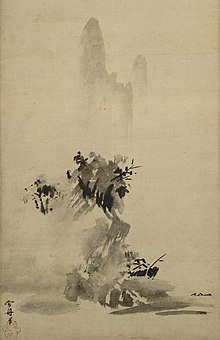haboku
Jump to navigation
Jump to search
English
[edit]
Etymology
[edit]From Japanese 破墨 (haboku はぼく), from Middle Chinese 破 (pʰà "broken up") + 墨 (mok "ink") (compare Mandarin pòmò 破墨, Cantonese po3-mak6 破墨).
Pronunciation
[edit]Noun
[edit]haboku (uncountable)
- A technique of using splashed ink in brushwork painting, especially for painting a landscape.
- 1979, John M. Rosenfield & William Jay Rathbun, Song of the Brush: Japanese paintings from the Sansō Collection, Seattle Art Museum
- The haboku idiom had appeared in South China in the thirteenth century, and appealed greatly to visiting Japanese Zen Buddhists, who took examples back with them.
- 2004, Benjamin Lee Wren, Teaching World Civilization With Joy and Enthusiasm, page 163:
- In the very year that the Void began in Kyoto, a Zen monk named Sesshu (1420-1506) left for Ming China and brought back to Japan haboku, or splash ink style and a love of wide open spaces in his paintings. […] Haboku reached its zenith during the Muromachi Period (1470–1550) and then declined.
- 2009, Fred S. Kleiner, Gardner's Art Through the Ages: Non-Western Perspectives, 13th edition, page 107:
- His most dramatic works are in the splashed-ink (haboku) style, a technique with Chinese roots. The painter of a haboku picture paused to visualize the image, loaded the brush with ink, and then applied primarily broad, rapid strokes, sometimes even dripping the ink onto the paper.
- 1979, John M. Rosenfield & William Jay Rathbun, Song of the Brush: Japanese paintings from the Sansō Collection, Seattle Art Museum
Usage notes
[edit]Although Japanese has terms to distinguish between the styles of 破墨 (haboku), which properly uses ink of contrasting shades, and 溌墨 (hatsuboku), in which the ink is "splashed", these terms in practice are used interchangeably in Japanese and even in English.
Translations
[edit]technique of using splashed ink in brushwork painting